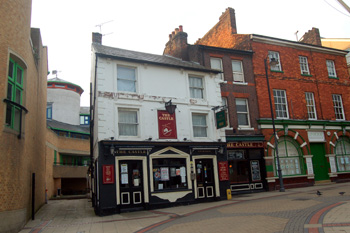The Castle Public House Castle Street Luton

The Castle August 2009
The Castle Public House: 1 Castle Street, Luton [formerly the White Hart then Scruffy Murphy]
As might be expected from its position in the old market place of the town, the Castle is one of Luton's older public houses. The building was listed by the former Department of Environment in 1981 as Grade II, of special interest. The accompanying description states that the building is mid 19th century. It is stucco-faced and has a Welsh slate roof. The building comprises three storeys with bracketed eaves and raised quoins. Until very recently the public house was called the White Hart (then, briefly, Scruffy Murphy, before changing to the Castle in the last year or two [time of writing 2009].
Despite its 19th century date, as reckoned by the Department of Environment, the White Hart may be a much older institution. A White Hart is recorded in Luton as early as 1733 [AD3289]. Given that this is a popular name for public houses it may not be on the exact site of the current public house but the description, that it abutted a property which itself abutted: "north on the common street from the marketplace to Cross pond" shows it was, at the very least, very close. As noted, the intersection of Castle Street, Park Square and George Street was the market place and was known as Market Hill. Cross Pond was in Park Square. The reference is simply to the White Hart abutting a property being assigned.
In 1778 Margaret, wife of Philip Hayward was buried in Luton and the parish register describes them as being "of the White Hart". The establishment is listed in the first countywide registers of alehouse licenses of 1882 to 1828 [CLP13] and in 1827 its owner, Thomas Carter, devised it in his will to his wife Ann [Z1294/1/15]. He died in 1829.
In 1872 the White Hart was put up for sale by auction by the trustees for sale under the will of Frederick Samuel Cleaver, deceased, along with eleven other licensed premises [CRT160/210]. It was described as "a brick-built House in a capital position, containing Good Bar, Bar Parlor [sic], Taproom, Kitchen, Cellar, Private Sitting Room and Five Bedrooms. A Large Yard in rear (with entrance in common with occupiers of adjoining premises), containing a brick and slated Store with Room over, a brick and tiled 4-stall Stable and Loft, a Printing Office adjoining, let to Mr. O'Doherty at £8 per annum, a Store and Stable let to Mr. Chamberlain at £8, a Store or Stale adjoining, and an open fronted Cart Lodge. The sub-tenant, Thomas George Edwards paid £1 per week rent. The property was leasehold and was leased by Cleaver for twenty one years from Christmas 1869 at a rent of £80 per annum. Sadly the particulars do not reveal who bought the property.
Surprisingly, the buyer in 1872 was not John William Green, whose Phoenix Brewery in Park Street West was just a stone's throw from the White Hart, although his firm did own land at the rear of the building and it also owned the adjoining property, 3 Castle Street. This building, now [September 2009] an employment agency was the headquarters of the Luton Wine Company, founded by Green's rival Luton brewer Thomas Sworder and sold to Green with the rest of Sworder's business in 1897.
At the time of writing [September 2009] the Castle remains a public house. It is owned by Camelot Inns and Taverns, a firm based in Hitchin [Hertfordshire].
Sources:
- AD3289: abuttal in a deed: 1733;
- ABT: burial: 1778;
- CLP13: register of alehouse licences: 1822-1828;
- Z1294/1/15: will of Thomas Carter devising the White Hart to his wife: 1827, proved 1829;
- CRT160/210: sale catalogue: 1872;
- Bedfordshire Magazine Volume II page 94: photograph: 1950s;
- WB/Green4/5/Lu/PSWB31: photograph of boarded up offices of J. W. Green Limited with the White Hart next door: 1982;
- WB/Green7/7/1: include in LutonTown centre Historic Pubs and Breweries Trail pamphlet: 1990s
List of Licensees: note that this is not a complete list; entries in italics refer to licensees where either beginning or end, or both, dates are not known:
1778: Philip Hayward;
1822-1828: Thomas Carter;
1828: Charles Hester;
1839: James Fensom;
1850-1854: Richard Stokes;
1861-1864: William Bayes or Boyes;
1869: J. Puddephatt;
1872: Thomas George Edwards
1872-1885: Samuel Chapman;
1890-1914: George Oakley;
1920: George Day;
1924-1930: Frederick Hill;
1930-1936: Arthur William Tonks;
1936-1938: Ada Tonks;
1938-1940: Ada Bradbury;
1940-1949: Archibald John Johnson;
1949-1954: Richard Clifford Jacobs;
1954: Herbert Starbuck;
1957: Dennis Charles Slaughter;
1961: Jack Frederick Cain;
1968: Robert Kirkpatrick;
1970: Alan Easton Pink;
1974: Patrick Norbert Coughlan;
1979: James O’Connell;
1991: Stephen Parker and Alan Cole;
1992: Stephen Parker and Richard Charles Phillips;
1993: Anthony David Pecconi and Richard Charles Phillips.